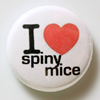

|
|||||
|
Home Spiny Mouse Links Natural
History Captive
Husbandry To recommend a link please send an email. Spiny Mouse Breeders To recommend a breeder please send an email. |
Spiny
Mouse Article By Russel Tofts There are 8 species of Spiny Mice in the genus Acomys but, of these, only 2 or 3 are regularly available, but by far the commonest is the Arabian Spiny Mouse (Acomys cahirinus dimidiatus) which enjoys a wide distribution from North Africa and Israel to Pakistan. There is some debate as to whether this latter species should be considered a full species in its own right, or is merely a larger and paler race or subspecies of the Egyptian Spiny Mouse (Acomys cahirinus cahirinus). They are best kept in a large aquarium with a well-fitting but well-ventilated lid and plenty of cage furnishings to keep them occupied. The tail is very brittle and, if the animal is grasped by this appendage, it may be shed, leaving behind just bare bone which, in the absence of a blood supply, will die and drop off after a few days. This is a successful survival technique, similar to that employed by certain lizards, known as "autonomy", but, unlike lizards, the tail does not regrow. The Spiny Mouse breeds easily but care must be taken to avoid overcrowding the cage as, in such circumstances, dominant members of the colony may start attacking smaller members of the clan with fatal consequences. They usually start by pulling the hair out or nipping at the ears or tail. If the injured animal is not removed quickly, it may be killed. The young (usually two) are born after a gestation period of 35-45 days and are very precocious at birth, being fully furred and mobile after just 24 hours. Females usually give birth in a standing position. The average longevity is 3-4 years (quite long for a "mouse"), with males usually outliving females. They thrive on a diet of seeds, with a piece of apple or dog biscuit for variety. Like many rodents, they appreciate some live food in their diet, particularly crickets or locust hoppers. Meal worms, too, are a useful dietary addition but should be fed fairly sparingly because they are deficient in calcium. A few meal worms twice or even three times a week is fine though. In January I was delighted to acquire two pairs of another distinctive race of this lovely animal, provisionally called the Lower Egyptian Spiny Mouse. In coloration it is similar to the Arabian subspecies but it has the nervous disposition and speed of the nominate race, and may yet prove to be a completely separate species. Article By Ratkateers Rodentry There are several different species of Spiny Mice. We breed and raise the Arabian or Cairo Spiny Mouse. They are beige with white bellies. Spiny mice make wonderful pets as well as being absolutely adorable. Their faces are fox-like, with huge eyes and ears. They can learn to recognize simple sounds and can be taught their name or stand up for a treat on command! The typical life span of a spiny mouse is 4 to 5years. Housing
Feed
|
 Click to join EFExotics  Pins and magnets in the store! Spiny
Mouse
Images
To submit genet images please send an email.
|
|||